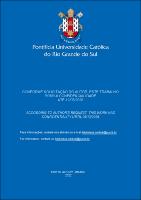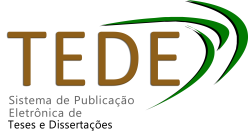| Share record |


|
Please use this identifier to cite or link to this item:
https://tede2.pucrs.br/tede2/handle/tede/10219Full metadata record
| DC Field | Value | Language |
|---|---|---|
| dc.creator | Costa, Bruna Pasqualotto | - |
| dc.creator.Lattes | http://lattes.cnpq.br/1222271171369228 | por |
| dc.contributor.advisor1 | Oliveira, Jarbas Rodrigues de | - |
| dc.contributor.advisor1Lattes | http://lattes.cnpq.br/9507382254235935 | por |
| dc.date.accessioned | 2022-05-12T14:52:45Z | - |
| dc.date.issued | 2022-03-30 | - |
| dc.identifier.uri | https://tede2.pucrs.br/tede2/handle/tede/10219 | - |
| dc.description.resumo | O câncer de endométrio é considerado o sexto tipo de câncer mais comumente diagnosticado na população feminina. Apesar da remoção cirúrgica ser o tratamento de escolha para a maioria das pacientes, cerca de 15 a 20% apresentem recidivas após a cirurgia. Com base em critérios patológicos pode ser recomendada a radioterapia e/ou quimioterapia adjuvante ao tratamento cirúrgico. No entanto, estima-se que estes tratamentos beneficiem apenas 10 a 15% das pacientes e, quando deseja-se preservar a fertilidade ou no caso de doença metastática e/ou recorrente, a terapia hormonal é um tratamento alternativo. Considerando as opções terapêuticas restritas e as altas taxas de resistência/recidiva tumoral, a busca por novos fármacos antitumorais se faz necessária. O presente estudo teve como objetivo avaliar o efeito antitumoral da frutose-1,6-bisfosfato (F1,6BP) e do metoxieugenol (MET) em uma linhagem celular humana de câncer de adenocarcinoma de endométrio (Ishikawa). As duas moléculas testadas apresentaram efeito antiproliferativo e não-citotóxico sobre as células de câncer endometrial, com aumento dos níveis de espécies reativas de oxigênio, disfunção mitocondrial com aumento do potencial de membrana mitocondrial e redução da capacidade proliferativa celular mesmo após a retirada do tratamento. Entretanto, os mecanismos quimioterápicos induzidos pelos tratamentos se mostraram distintos: enquanto a F1,6BP foi responsável pela indução de morte celular programada por apoptose com aumento da expressão gênica de reguladores pró-apoptóticos p53 e Bax, o tratamento com MET levou a um aumento da área nuclear e do conteúdo lisossomal celular que, em conjunto com o aumento da expressão gênica de p53/ p21 e diminuição da expressão gênica de CDK4/6, corroboram com o desencadeamento de um efeito antiproliferativo por senescência celular. Os resultados demonstram que as moléculas em estudo podem atuar como potenciais agentes antitumorais contra o câncer de endométrio. Em células não tumorais renais (Vero), os tratamentos com a F1,6BP e o MET não apresentaram citotoxicidade e demonstraram potencialmente aumentar a tolerância destas células frente à toxicidade induzida por cisplatina. | por |
| dc.description.abstract | Endometrial cancer is considered the sixth most commonly diagnosed cancer in the female population. Although surgical removal is the treatment of choice for most patients, about 15 to 20% have recurrences after surgery. Radiotherapy and/or chemotherapy adjuvant to surgical treatment may be recommended based on pathological criteria. However, it is estimated that these treatments benefit only 10 to 15% of patients. In the case of preserving fertility or metastatic and/or recurrent disease, hormone therapy is an alternative treatment. Considering the restricted therapeutic options, high rates of tumor resistance, and recurrence, the search for new antitumor drugs is necessary. The present study aimed to evaluate the antitumoral effect of fructose-1,6-bisphosphate (F1,6BP) and methoxyeugenol (MET) in a human cell line of endometrial adenocarcinoma cancer (Ishikawa). Both molecules tested showed antiproliferative and non-cytotoxic effects in endometrial cancer cells, followed by increased levels of reactive oxygen species, mitochondrial dysfunction with increased mitochondrial membrane potential, and reduced cell proliferative capacity even after treatment withdrawal. However, the chemotherapeutic mechanisms induced by the treatments were different: while F1,6BP was responsible for the induction of programmed cell death by apoptosis with increased gene expression of pro-apoptotic regulators p53 and Bax, treatment with MET led to an increase in the nuclear area and cell lysosomal content which, together with the increase in p53/p21 gene expression and decrease in CDK4/6 gene expression, corroborate the triggering of an antiproliferative effect by cellular senescence. The results demonstrate that the molecules under study can act as potential antitumor agents against endometrial cancer. In non-tumoral renal cells (Vero), the treatments with F1,6BP and MET showed non-cytotoxic effects and potentially increased the tolerance of these cells against cisplatin-induced toxicity. | eng |
| dc.description.provenance | Submitted by PPG Biologia Celular e Molecular ([email protected]) on 2022-05-10T18:46:58Z No. of bitstreams: 1 BRUNA_PASQUALOTTO_COSTA_TES.pdf: 10256771 bytes, checksum: 80920cf554d6954c061a7bdd76f8eba1 (MD5) | eng |
| dc.description.provenance | Approved for entry into archive by Sarajane Pan ([email protected]) on 2022-05-12T14:43:29Z (GMT) No. of bitstreams: 1 BRUNA_PASQUALOTTO_COSTA_TES.pdf: 10256771 bytes, checksum: 80920cf554d6954c061a7bdd76f8eba1 (MD5) | eng |
| dc.description.provenance | Made available in DSpace on 2022-05-12T14:52:45Z (GMT). No. of bitstreams: 1 BRUNA_PASQUALOTTO_COSTA_TES.pdf: 10256771 bytes, checksum: 80920cf554d6954c061a7bdd76f8eba1 (MD5) Previous issue date: 2022-03-30 | eng |
| dc.description.sponsorship | Coordenação de Aperfeiçoamento de Pessoal de Nível Superior - CAPES | por |
| dc.format | application/pdf | * |
| dc.thumbnail.url | https://tede2.pucrs.br/tede2/retrieve/184023/TES_BRUNA_PASQUALOTTO_COSTA_CONFIDENCIAL.pdf.jpg | * |
| dc.language | por | por |
| dc.publisher | Pontifícia Universidade Católica do Rio Grande do Sul | por |
| dc.publisher.department | Escola de Ciências Saúde e da Vida | por |
| dc.publisher.country | Brasil | por |
| dc.publisher.initials | PUCRS | por |
| dc.publisher.program | Programa de Pós-Graduação em Biologia Celular e Molecular | por |
| dc.rights | Acesso Aberto | por |
| dc.subject | Câncer de Endométrio | por |
| dc.subject | Frutose-1,6-bisfosfato | por |
| dc.subject | Metoxieugenol | por |
| dc.subject | Novas Moléculas Terapêuticas | por |
| dc.subject | Efeito Antitumoral | por |
| dc.subject | Endometrial Cancer | eng |
| dc.subject | Fructose-1,6-bisphosphate | eng |
| dc.subject | Methoxyeugenol | eng |
| dc.subject | New Therapeutic Molecules | eng |
| dc.subject | Antitumor Effect | eng |
| dc.subject.cnpq | CIENCIAS BIOLOGICAS::BIOLOGIA GERAL | por |
| dc.title | Avaliação do efeito antitumoral da frutose-1,6-bisfosfato e do metoxieugenol em adenocarcinoma de endométrio humano in vitro | por |
| dc.type | Tese | por |
| dc.restricao.situacao | Trabalho será publicado como artigo ou livro | por |
| dc.restricao.prazo | 48 meses | por |
| dc.restricao.dataliberacao | 12/05/2026 | por |
| Appears in Collections: | Programa de Pós-Graduação em Biologia Celular e Molecular | |
Files in This Item:
| File | Description | Size | Format | |
|---|---|---|---|---|
| TES_BRUNA_PASQUALOTTO_COSTA_CONFIDENCIAL.pdf | BRUNA_PASQUALOTTO_COSTA_TES | 645.68 kB | Adobe PDF |  Download/Open Preview |
Items in DSpace are protected by copyright, with all rights reserved, unless otherwise indicated.




